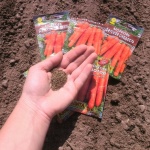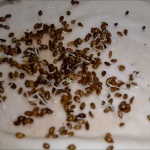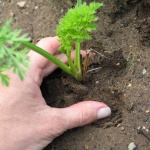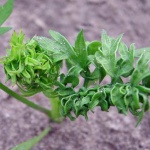
- Authors: Ural
- Appointment: for fresh consumption, for canning, for freezing, for making juice
- Weight, g: 94-155
- The form : cylindrical
- Taste qualities: very high
- Ripening terms: mid-season
- The size : average
- Length, cm: up to 19
- Bark coloration: bright orange
- Keeping quality: good
Squirrel is one of the high-yielding varieties of carrots that attracts gardeners with strong immunity and excellent taste characteristics. It is worth considering the key features of carrots, as well as understanding how to grow a crop.
Description of the variety
Carrot Squirrel is a rather compact plant with long tops of rich green color. Among the features of the plant, there is a high survival rate even in harsh conditions, as well as an excellent yield indicator, for which the culture is appreciated by gardeners.
Characteristics of the appearance of the plant and root crops
The variety forms large root crops with the following characteristics:
- weight - up to 155 g;
- maximum length - 19 cm;
- cylindrical shape;
- smooth and dense skin of bright orange color.
Carrots are suitable for long distance transportation, while retaining their attractive appearance and taste.
Purpose and taste of tubers
Tasters appreciate the impressive amount of useful components and vitamins that are contained in the popular variety of root vegetables. The squirrel is suitable both for fresh consumption and for preparing first or second courses, freezing, preservation. At the same time, the roots retain their beneficial properties and do not lose their juicy sweet taste.
Maturation
Carrot Squirrel belongs to the group of mid-season plants. The formation of root crops in a culture takes from 130 to 135 days from the moment the seeds are planted in open ground. During this time, the fruits accumulate the maximum amount of nutrients, become juicy and sweet.
Yield
The variety is famous for its large roots. The yield indicator per square meter reaches 5.2 kg. If desired, it can be increased by following the agrotechnical recommendations for plant care.
Growing and care
You can get a large number of carrots through a competent approach to growing. The variety is sown with seeds in open ground, having previously prepared the seed. Carrot seeds are subjected to the following procedures.
- Selected. Keep whole and large samples and discard the rest.
- Disinfect. For this, the seeds are placed in a solution of potassium permanganate of low concentration.
- They stimulate. The seeds are sprayed with special formulations that accelerate the growth of the culture and promote the rapid emergence of seedlings.
Also, gardeners prepare the soil by pre-applying fertilizers and loosening the soil. Planting carrots is carried out in warm and sunny weather, when the air temperature warms up to 15 degrees, and the soil temperature - up to 10 degrees Celsius. Planting usually occurs in late spring or early summer. Scheme:
- between the rows they recede up to 15 cm;
- a distance of 5 cm is maintained between the seeds;
- planting depth is 1-2 cm.
To achieve high yields, it is important to organize careful plant care. This will require taking into account a number of points.
- Watering. The culture is especially undemanding to watering, it is recommended to add water to the soil 1-2 times a week, adjusting the volume and frequency, based on climatic conditions.For example, in a drought, carrots will need more water, and during rains, watering can be completely abandoned.
- Loosening. The procedure is carried out immediately after the introduction of moisture into the soil, saturating it with the necessary amount of oxygen and accelerating the flow of nutrients to the roots of the plant. Additionally, gardeners recommend weeding the beds.
- Top dressing. On average, the culture is fed 3-4 times per season. Basically, fertilizers are applied during the period of active growth and fruiting of carrots in order to achieve juicy and sweet root crops. Mineral compositions are used as fertilizers, including phosphorus and potash mixtures.
If necessary, it is recommended to thin out the beds in the first two weeks after planting the seeds. Usually, the procedure is started if several rows are too close.

Carrots are one of the most unpretentious crops in terms of growing conditions; they can endure a short drought and a short cold snap. However, to get tasty and large root crops, you should adhere to the basic rules for planting carrots.


Soil requirements
Squirrel carrots should be grown in fertile and light soils. Recommendations for choosing a location:
- it should be sunny and calm;
- the acidity indicator of the soil should be neutral;
- groundwater must run deep.
If the garden does not have areas with a low groundwater table, a drainage system will need to be provided. Otherwise, the roots of the carrots will quickly rot, as will the roots.
Disease and pest resistance
The squirrel shows excellent resistance to most diseases and pests. However, gardeners recommend carrying out preventive treatment of the crop, starting with seeds, which are placed in a solution of potassium permanganate before planting.
Plants that have already released leaves and have begun to form root crops should also be processed. Then it will be possible to save the carrots from the attacks of pests and common diseases.

Carrots grow in almost any garden. There is an opinion that this culture is very resistant to all kinds of diseases and pests, but this is not the case. Without proper care, carrots become susceptible to all kinds of infections and are affected by harmful insects.
Review overview
The squirrel is considered one of the popular varieties. According to gardeners' reviews, the advantages of carrots include:
- high yield rate;
- unpretentious care;
- large fruits.
Also, the variety attracts gardeners by the lack of a requirement for frequent watering.







































































